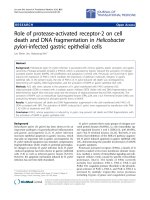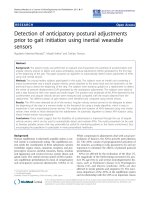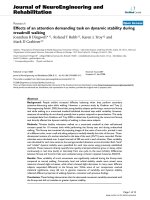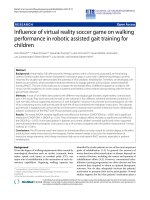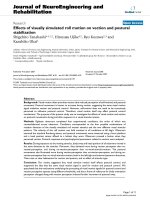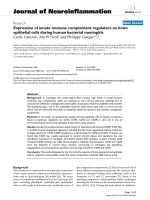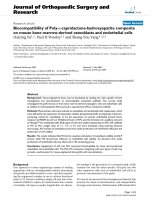Báo cáo hóa học: " Fabrication of Antireflective Sub-Wavelength Structures on Silicon Nitride Using Nano Cluster Mask for Solar Cell Application" ppt
Bạn đang xem bản rút gọn của tài liệu. Xem và tải ngay bản đầy đủ của tài liệu tại đây (356.51 KB, 4 trang )
NANO EXPRESS
Fabrication of Antireflective Sub-Wavelength Structures
on Silicon Nitride Using Nano Cluster Mask for Solar Cell
Application
Kartika Chandra Sahoo Æ Men-Ku Lin Æ
Edward-Yi Chang Æ Yi-Yao Lu Æ Chun-Chi Chen Æ
Jin-Hua Huang Æ Chun-Wei Chang
Received: 7 February 2009 / Accepted: 5 March 2009 / Published online: 22 April 2009
Ó to the authors 2009
Abstract We have developed a simple and scalable
approach for fabricating sub-wavelength structures (SWS)
on silicon nitride by means of self-assembled nickel
nanoparticle masks and inductively coupled plasma (ICP)
ion etching. Silicon nitride SWS surfaces with diameter of
160–200 nm and a height of 140–150 nm were obtained. A
low reflectivity below 1% was observed over wavelength
from 590 to 680 nm. Using the measured reflectivity data
in PC1D, the solar cell characteristics has been compared
for single layer anti-reflection (SLAR) coatings and SWS
and a 0.8% improvement in efficiency has been seen.
Keywords Sub-wavelength Structure Á Solar cell Á
SWS fabrication Á Reflectance Á Anti-reflective coatings
Introduction
The antireflection coating has become a key feature for
solar cell design [1–4]. Many researchers have investigated
double-layer antireflection (DLAR) coatings because
single-layer antireflection coatings (SLAR) are not able
to cover a broad range of the solar spectrum [5, 6].
Unfortunately, multilayer ARCs are expensive to fabricate
owing to the stringent requirement of high vacuum,
material selection, and layer thickness control. Addition-
ally, thermal mismatch induced lamination and material
diffusion of the multilayer ARCs limit the device perfor-
mance at high power densities.
An alternative to multilayer ARCs are the sub-wave-
length structured (SWS) surface with dimensions smaller
than the wavelength of light [7]. In publications concerning
broadband or solar anti-reflective surfaces, [8–11] the
principle to achieve the necessary low refractive indices is
always the same: substrate material is mixed with air on a
sub-wavelength scale. To date, a wide variety of techniques
have been investigated for texturing multi-crystalline (mc)
silicon cells [12]. One of the promising options is surface
texturing by dry etching technique. Some groups have
succeeded in fabricating uniform textures with a submicron
scale on mc-Si wafers by reactive ion etching and applied
to the Si solar cells [13, 14]. Unfortunately, there is not
much report on texturization of silicon nitride and the
optical properties of submicron textures on silicon nitride
for the application of solar cells.
In this study, we fabricated sub-wavelength structure
on antireflection coating layers instead of semiconductor
layer on solar cell. The main motivation behind this lies
in the fact that the sub-wavelength structures will act as a
second ARC layer with an effective refractive index so
that the total structure can perform as a DLAR layer.
Thus we can cost down the deposition of 2nd ARCs layer
can be saved with better or comparable performance as
that of a DLAR solar cell. We fabricate the silicon nitride
sub-wavelength structures using the mask less RIE tech-
nique on silicon substrate and explore the reflection
properties of the texturing structures through spectro-
scopic measurements [15].
K. C. Sahoo Á E Y. Chang (&) Á Y Y. Lu Á C C. Chen
Department of Materials Science and Engineering,
National Chiao Tung University, Hsinchu, Taiwan
e-mail:
M K. Lin Á J H. Huang
Department of Materials Science and Engineering,
National Tsing Hua University, Hsinchu, Taiwan
C W. Chang
Taiwan Semiconductor Manufacturing Company Ltd,
Hsinchu, Taiwan
123
Nanoscale Res Lett (2009) 4:680–683
DOI 10.1007/s11671-009-9297-7
Experiment
The fabrication procedure is schematically shown in Fig. 1.
First of all the polished (100) silicon was cleaned with
dilute HF to remove the native oxide. A layer of
(200 ± 0.05) nm thick silicon nitride (Si
3
N
4
) was then
deposited on a polished (100) silicon wafer by plasma
enhanced chemical vapor deposition (PECVD) technique.
A nickel film with a thickness of (15 ± 0.05) nm was then
evaporated on the silicon nitride surface using an E-beam
evaporating system. The nickel film was then rapid thermal
annealed (RTA) under the forming gas (mixture of H
2
and
N
2
) with a flow rate of 3 sccm at 850 °C for 60 s to form
nickel clusters, which served as the etch masks for silicon
nitride. The sample is then etched by ICP etching with bias
power of 200 watt to form the sub-wavelength structures
using a gas mixture of CF
4
/O
2
with flow rate of 60 and
6 sccm for CF
4
and O
2
, respectively. To remove the
residual nickel mask, the sample was dipped into pure
nitric acid (HNO
3
) solution for 5 min at room temperature.
The diameter and density of the fabricated sub-wavelength
structures were nearly the same as those of the nickel
cluster masks, while the height was controlled by the
etching time. The morphology of SWS was analyzed by
scanning electron micrograph (SEM). The reflectance of
the SWS were measured using an n&k analyzer (model:
1280, N&K Tech. Inc.).
Results and Discussion
Figure 2a shows the SEM images of the nickel nanoclus-
ters formed after rapid thermal annealing at 850 °C for
60 s. The diameters of the nanoclusters were varied from
160 to 200 nm. Figure 2b shows the SEM image of the
fabricated SWS on silicon nitride after ICP dry etching for
120 s. From Fig. 2b, the height of the silicon nitride SWS
was measured to be 140–150 nm, diameters of fabricated
SWSs were varied from 160–200 nm, which were same as
that of nickel nanoclusters.
Figure 3 shows the comparison of the measured reflec-
tivity from a polished silicon wafer with 69.1 nm silicon
nitride SLAR coating and fabricated silicon nitride SWS on
silicon wafer. The flat silicon substrate exhibits high-
reflection [35% for visible and near infrared wavelengths,
silicon nitride SLAR coatings exhibits low-reflection\20%
for long wavelengths 700 nm and high-reflection[35% for
shorter wavelengths 400 nm, and silicon nitride/MgF
2
DLAR coatings exhibits low-reflection \10% for long
wavelengths 700 nm and high-reflection [20% for short
wavelength 400 nm, while the SWS gratings show reduced
reflection of \10% for long wavelengths 700 nm and
shorter wavelengths 400 nm. The reflection is further
reduced to\1% for wavelengths around 580–680 nm. The
silicon nitride SWS gratings exhibit lower reflection than
colloid-based antireflection coatings on crystalline silicon
solar cells, [16] other SWS ARCs made by lithographic
techniques with typical reflection of *2–10% [8, 17–20],
Additionally, optimization of the height and non-etched part
of silicon nitride of SWS will facilitate further improvement
of the antireflection performance.
AR design has been characterized by its average residual
reflectance R
av
,[21] which is defined by the equation
R
av
¼
1
k
u
À k
l
Z
k
u
k
l
R kðÞdk; ð1Þ
where R(k) is the reflectance of the design and k
l
and k
u
are
the lower and upper wavelength of the design window. The
average residual reflectance R
av
has been calculated using
the Eq. 1 by taking the wavelength range from 350 to
1000 nm into consideration for a bare Si, SLAR w/Si
3
N
4
Fig. 1 Schematic illustration of
the process steps for fabricating
SWS gratings on silicon nitride
Nanoscale Res Lett (2009) 4:680–683 681
123
thickness of 69.1 nm, DLAR of Si
3
N
4
/MgF
2
w/thickness of
69.1 nm and 56 nm, respectively for Si
3
N
4
and MgF
2
, and
fabricated Si
3
N
4
SWS. The results are shown in Table 1.
From Table 1 it is clear that the silicon nitride SWS has the
lowest average residual reflectance of 4.28% as compared
to bare silicon, 69.1 nm silicon nitride SLAR coatings and
DLAR coating with 69.1 nm silicon nitride and 56 nm
MgF
2
. For the consideration of working wavelength region
of silicon-based solar cells, the pyramid structure with
height of 140–150 nm is suitable as the antireflective
structure and believed to increase the solar cell perfor-
mance as compared to solar cell w/SLAR structure.
To investigate the performance of silicon nitride SWS
before fabricating on a real silicon solar cell, we simulated
the solar cell performance using PC1D software. The
reflectance spectra obtained from measurement were used
in PC1D simulations to compare the effect on the short
circuit current density (J
SC
), open circuit voltage (V
OC
) and
efficiency (g) for a solar cell structure based on the standard
PC1D template for a low cost silicon solar cell. The silicon
material was set to p-type with resistivity of 1.008 X cm
and a diffused emitter with error function distribution and
99.4 X/sq. emitter sheet resistances. The base contact had a
resistance of 0.015 X and the cell had an internal shunt of
0.3 Siemens. The bulk life time was set to 7.03 ls with a
front surface recombination velocity of 1800 cm/s and back
surface recombination velocity of 25 cm/s [http://www.
semiconductor.net/article/CA6572786.html]. The output
characteristics and parameters obtained from PC1D for
SLAR, DLAR and silicon nitride SWS are shown in Fig. 4.
It is clear that J
SC
, V
OC
of silicon nitride SWS are higher
than silicon nitride SLAR structure as seen from Fig. 4.A
clear increase in efficiency of 0.8% can be seen for silicon
solar cell with silicon nitride SWS over a cell with single
layer silicon nitride ARCs and only 0.3% less in efficiency
than the DLAR coated solar cell, which is believed to be due
to lower reflectance of DLAR to silicon nitride SWS over
the longer wavelength region (i.e. k [ 600 nm) that leads to
lower short circuit current. From the above observations we
can conclude that the efficiency of solar cell may not
Fig. 2 SEM Images a Nickel nano-clusters formed after rapid thermal annealing at 850 °C for 60 s, b Fabricated silicon nitride SWSs after dry
etching with ICP for 120 s
Wavelength (nm)
400 500 600 700 800 900 1000
Reflectance (%)
0
10
20
30
40
50
60
Si
3
N
4
SWS
Bare Si
SLAR
DLAR
Si Substrate
Si
3
N
4
ARC
n=2.03, t = 691A
Si Substrate
Si
3
N
4
ARC
n=2.03, t = 691A
MgF
2
ARC
n=1.38, t = 560A
SLAR
DLAR
Fig. 3 Measured optical reflectivity at normal incidence for bare
(100) silicon wafer, fabricated 140*150 nm height silicon SWS,
SLAR w/silicon nitride of 69.1 nm deposited on silicon wafer and
DLAR w/69.1 nm silicon nitride and 56 nm MgF
2
deposited on
silicon wafer
Table 1 Average residual reflectivity calculated by the Eq. 1 for
measured reflectance of bare silicon, 69.1 nm silicon nitride deposited
on silicon, 69.1 nm silicon nitride and 56 nm MgF
2
double layer
deposited on silicon and 140–150 nm silicon nitride SWS fabricated
on silicon
Structure Average residual reflectivity,
R
av
(%)
Silicon 35.61
Silicon nitride SLARC 11.22
Silicon nitride/MgF
2
DLARC 7.64
Silicon nitride SWS 4.28
SLARC Single layer anti-reflective coating, DLARC Double layer
anti-reflective coating, SWS Sub-wavelength structure
682 Nanoscale Res Lett (2009) 4:680–683
123
depend on the average reflectance, but, significantly on the
reflectance of ARCs in longer wavelength region.
Conclusion
In summary, we have developed an easy and scalable non-
lithographic approach for creating sub-wavelength struc-
tured antireflection coatings directly on silicon nitride anti-
reflection coatings for the first time to improve the solar
cell efficiency. PC1D simulated solar characteristics
inferred that the efficiency increase of 0.8% for a silicon
solar cell can be achieved using silicon nitride SWS over a
cell with silicon nitride SLAR and a comparable perfor-
mance with a cell with silicon nitride and MgF
2
DLAR.
Acknowledgments This work was supported in part by Taiwan
National Science Council (NSC) under Contract NSC-97-2221-E-
009-001-PAE, Motech Industries Inc. (MOTECH), Tainan, Taiwan,
under 2008–2009 grants and by Laser application Department,
Industrial Technology Research Institute, Hsinchu, Taiwan, under a
2008 grant.
References
1. L. Tsakalakos et al., J. Nanophotonics 1, 1 (2007)
2. M.A. Green, High Efficiency Silicon Solar Cells (Trans Tech
Publication, Aedermannsdorf, Switzerland, 1987)
3. S.M. Sze, Semiconductor Devices, Physics and Technology
(Wiley, New York, 1985), p. 315
4. S. Strehlke, S. Bastide, J. Guillet, C. Levy-Clement, Mater. Sci.
Eng. B 69, 81 (2000). doi:10.1016/S0921-5107(99)00272-X
5. J. Zhao, A. Wang, P. Altermatt, M.A. Green, Appl. Phys. Lett.
66, 3636 (1995). doi:10.1063/1.114124
6. S.E. Lee, S.W. Choi, J. Yi, Thin Solid Films 376, 208 (2000). doi:
10.1016/S0040-6090(00)01205-0
7. H. Sai, H. Fujii, K. Arafune, Y. Ohshita, M. Yamaguchi,
Y. Kanamori, H. Yugami, Appl. Phys. Lett. 88, 201116 (2006).
doi:10.1063/1.2205173
8. P. Lalanne, G.M. Morris, Nanotechnology 8, 53–56 (1997). doi:
10.1088/0957-4484/8/2/002
9. Y.C. Chang, G.H. Mei, T.W. Chang, T.J. Wang, D.Z. Lin, C.K.
Lee, Nanotechnology 18, 285–303 (2007)
10. M.J. Minot, J. Opt. Soc. Am. 66, 515 (1976). doi:10.1364/
JOSA.66.000515
11. T. Glaser, A. Ihring, W. Morgenroth, N. Seifert, S. Schro
¨
ter,
V. Baier, Microsyst. Technol. 11, 86–90 (2005)
12. D.H. Macdonald, A. Cuevas, M.J. Kerr, C. Samundsett, D. Ruby,
S. Winderbaum, A. Leo, Sol. Energy 76, 277–283 (2004). doi:
10.1016/j.solener.2003.08.019
13. Y. Inomata, Sol. Energy Mater. Sol. Cells 48, 237–242 (1997).
doi:10.1016/S0927-0248(97)00106-2
14. H.F.W. Dekkers, Opto-Electron. Rev. 8, 311–316 (2000)
15. M. Okuda, S. Matsutani, A. Asai, A. Yamano, K. Hatanaka,
T. Hara and T. Nakagiri, SID Symp. Digest (2000) 185–188
16. B.G. Prevo, E.W. Hon, O.D. Velev, J. Mater. Chem. 17, 791
(2007). doi:10.1039/b612734g
17. C. Aydin, A. Zaslavsky, G.J. Sonek, J. Goldstein, Appl. Phys.
Lett. 80, 2242 (2002). doi:10.1063/1.1466519
18. Y. Kanamori, E. Roy, Y. Chen, Microelectron. Eng. 78–79, 287
(2005). doi:10.1016/j.mee.2004.12.039
19. Y. Kanamori, M. Sasaki, K. Hane, Opt. Lett. 24, 1422 (1999).
doi:10.1364/OL.24.001422
20. E.B. Grann, M.G. Moharam, D.A. Pommet, J. Opt. Soc. Am. A
12, 333 (1995). doi:10.1364/JOSAA.12.000333
21. H.A. Macleod, Thin-Film Optical Filters, 3rd edn (Institute of
Physics, Bistol, 2001)
Applied Voltage (Volts)
0.0 0.1 0.2 0.3 0.4 0.5 0.6 0.7
Current Density (mA/cm
2
)
0
10
20
30
40
SLAR Si
3
N
4
(691A)
DLAR Si
3
N
4
/ MgF
2
(691 A/ 560 A)
Si
3
N
4
SWS
Structure V
OC
(Volts) J
SC
(mA/cm
2
) Efficiency (%)
SLAR 0.612 33.21 14.67
DLAR 0.612 35.72 15.85
Si
3
N
4
SWS 0.612 35.20 15.47
Fig. 4 PC1D Simulated solar characteristics for silicon nitride SWS,
silicon nitride SLAR, and silicon nitride/MgF
2
DLAR
Nanoscale Res Lett (2009) 4:680–683 683
123
